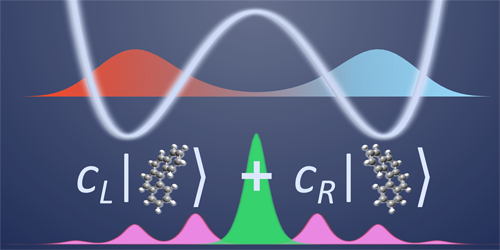This page contains automatically translated content.
New experiment for the study of chiral molecules
 Image: Dr. Daqing Wang.
Image: Dr. Daqing Wang.Similar to human hands, most complex molecules can exist in two versions: left-handed and right-handed. However, the two mirror images, called enantiomers, are not identical because they cannot be superimposed by rotation or translation. This difference can cause significant changes in the chemical reactivity and biological function of the molecules.
In their current study, researchers from the Universities of Kassel, Duisburg-Essen and Marburg show how chiral molecules can be brought into a quantum superposition of left- and right-handed enantiomers using matter wave interference. This enables novel table-top experiments on the question of how the behavior of left- and right-handed molecules differs at the quantum level.
Superposition and quantum tunneling
"A fascinating property of chiral molecules is that they can convert from their left-handed to their right-handed form through a process known as 'quantum tunneling,'" said Dr. Daqing Wang, an experimental physicist at the University of Kassel in Germany.
"This transformation can be thought of as crossing a high mountain - it takes a lot of energy to reach the top. But quantum physics allows you to tunnel right through the mountain instead," explained Dr. Benjamin Stickler, a quantum physicist at the University of Duisburg-Essen. During tunneling, the molecule is in a quantum superposition between the two forms. "It's like the thought experiment on Schrödinger's cat: a cat is in a locked box. From the outside, you don't know if the cat is alive or dead. This is the state of superposition," Wang describes.
In their study, the scientists demonstrate a novel method to specifically create this quantum state. This is a challenge because the duration of tunneling varies significantly depending on the molecule, ranging from longer than the age of the universe to less than a millionth of a second. Two conditions are thus required to study quantum tunneling in the laboratory: First, a group of molecules must be identified that tunnels on an accessible time scale, and second, the molecules must first be prepared in a form with a specific handedness.
The proposed experiment
Helizen (helix-shaped molecule) properties proved to be suitable. In the latest study, the researchers show that variants of the helicene molecule provide tunneling times in a range suitable for table-top experiments. One can prepare the molecules in well-defined quantum superpositions of their left- and right-handed shapes by double-slit interference from a laser grating and spatial filtering. Importantly, these superpositions can be prepared using state-of-the-art technology. This enables quantum experiments in which the interaction of chiral molecules with atoms, other molecules and surfaces can be studied with unprecedented precision.
The project was led by Dr. Daqing Wang (University of Kassel) and Dr. Benjamin Stickler (University of Duisburg-Essen). The work was funded by the Collaborative Research Center SFB 1319 ELCH.
More information:
The article Enantiomer superpositions from matter-wave interference of chiral molecules was published here: https://journals.aps.org/prx/abstract/10.1103/PhysRevX.11.031056
Contact:
Dr. Daqing Wang
Experimental Physics I
University of Kassel
Email: daqing.wang[at]uni-kassel[dot]de
Tel: 0561 804-4338